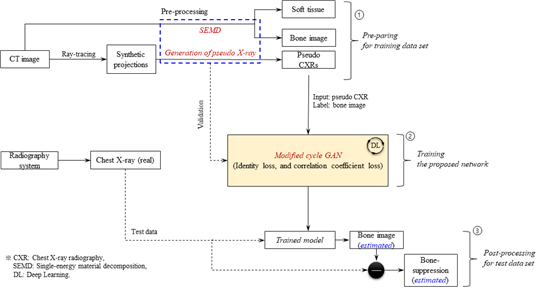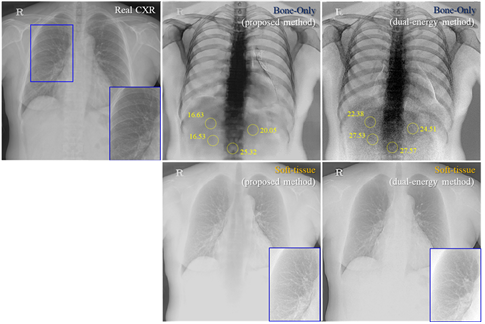글로벌 연구동향
의학물리학
- [Med Phys .] Framework for dual-energy-like chest radiography image synthesis from single-energy computed tomography based on cycle-consistent generative adversarial network
연세대 / 이민재, 조효성*
- 출처
- Med Phys .
- 등재일
- 2024 Feb
- 저널이슈번호
- 51(2):1509-1530. doi: 10.1002/mp.16329. Epub 2023 Mar 17.
- 내용
Abstract
Background: Dual-energy (DE) chest radiography (CXR) enables the selective imaging of two relevant materials, namely, soft tissue and bone structures, to better characterize various chest pathologies (i.e., lung nodule, bony lesions, etc.) and potentially improve CXR-based diagnosis. Recently, deep-learning-based image synthesis techniques have attracted considerable attention as alternatives to existing DE methods (i.e., dual-exposure-based and sandwich-detector-based methods) because software-based bone-only and bone-suppression images in CXR could be useful.Purpose: The objective of this study was to develop a new framework for DE-like CXR image synthesis from single-energy computed tomography (CT) based on a cycle-consistent generative adversarial network.
Methods: The core techniques of the proposed framework are divided into three categories: (1) data configuration from the generation of pseudo CXR from single energy CT, (2) learning of the developed network architecture using pseudo CXR and pseudo-DE imaging using a single-energy CT, and (3) inference of the trained network on real single-energy CXR. We performed a visual inspection and comparative evaluation using various metrics and introduced a figure of image quality (FIQ) to consider the effects of our framework on the spatial resolution and noise in terms of a single index through various test cases.
Results: Our results indicate that the proposed framework is effective and exhibits potential synthetic imaging ability for two relevant materials: soft tissue and bone structures. Its effectiveness was validated, and its ability to overcome the limitations associated with DE imaging techniques (e.g., increase in exposure dose owing to the requirement of two acquisitions, and emphasis on noise characteristics) via an artificial intelligence technique was presented.
Conclusions: The developed framework addresses X-ray dose issues in the field of radiation imaging and enables pseudo-DE imaging with single exposure.


Affiliations
Minjae Lee 1, Hunwoo Lee 1, Dongyeon Lee 1, Hyosung Cho 1, Jaegu Choi 2, Bo Kyung Cha 2, Kyuseok Kim 3
1Department of Radiation Convergence Engineering, Yonsei University, Wonju, Republic of Korea.
2Electro-Medical Device Research Center, Korea Electrotechnology Research Institute (KERI), Hanggaul-ro, Sangnok-gu, Ansan-si, Gyeonggi-do, Republic of Korea.
3Department of Integrative Medicine, Major in Digital Healthcare, Yonsei University College of Medicine, Gangman-gu, Unju-ro, Republic of Korea.
- 키워드
- chest X-ray radiographs; deep learning; dual-energy; synthesized dual-energy imaging.
- 연구소개
- 최근 연구에서는 기존의 이중 에너지(Dual-energy, DE) 흉부 방사선 촬영(CXR)을 대체할 새로운 프레임워크 개발에 주목하고 있습니다. 이 기술은 연조직과 뼈 구조를 선택적으로 영상화하여 다양한 흉부 병리(예: 폐 결절, 뼈 병변 등)를 더 정확하게 특성화하고, CXR 기반 진단의 개선 가능성을 모색합니다. 특히, 이번 연구는 단일 에너지 컴퓨터 단층촬영(CT)에서 DE와 유사한 CXR 영상 합성을 위한 새로운 프레임워크를 개발하는 것을 목표로 합니다. 이를 위해, AI 기반으로 한 프레임워크가 제안되었습니다. 제안된 프레임워크는 가상 CXR 생성부터 실제 단일 에너지 CXR에 대한 학습 및 추론까지, 세 가지 주요 기술로 구분됩니다. 연구 결과는 제안된 프레임워크가 소프트웨어 기반의 뼈 전용 및 뼈 억제 이미지를 CXR에서 유용하게 사용할 수 있는 대안으로서의 가능성을 보여줍니다. 이 연구는 특히 방사선 영상 분야에서 X-선의 선량 문제를 해결하고, 단일 노출로 가상 DE 영상을 가능하게 하는 새로운 방법론을 제시함으로써 의료 영상 진단의 질을 향상시킬 수 있는 유망한 접근 방식을 제시합니다.
- 덧글달기









